Canoe vs. Kayak: Which to Chose
As you start shopping for your next watercraft, kayaks and canoes can seem very similar. They're lightweight boats that transport people across various bodies of water, including lakes, rivers, and even oceans. There are specific differences between the two. Before you plan your next trip, learn to understand the difference between kayaking and canoeing.
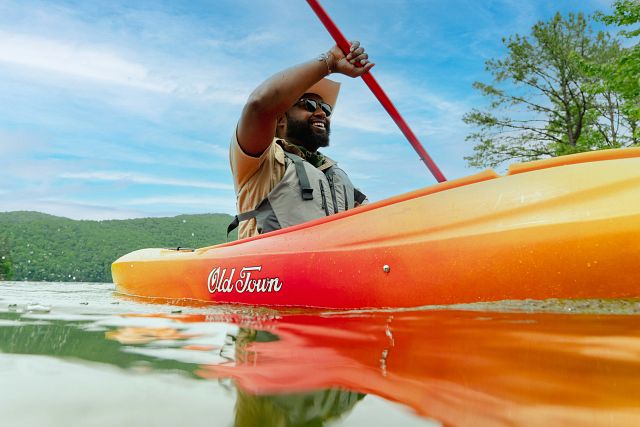
Canoe vs. Kayak: What's the Difference
A kayak is a type of watercraft that is propelled with a double-bladed paddle or pedals. Kayaks can come in a variety of versions-from sit-on-top to pedal to paddle. In a kayak, your legs are outstretched.
A canoe is an open boat that is paddled with either a single- or double-bladed paddle. Canoes are typically larger and can hold more gear, making them a good choice for longer trips.
The primary difference between kayaks and canoes is that kayaks are the overall shape, design, size, and use of the watercraft. These distinctions affect the way each boat moves through the water.
Key Differences Between Canoes and Kayaks
Size - Canoes are generally larger and heavier than kayaks, giving them more weight capacity on the water, though it can make them more difficult to transport..
Shape - Canoes are wider and have an open deck. Kayaks often, though not always, have a narrower hull and can come with either a closed or open deck. Open decks offer more room, while closed decks offer a more secure seat.
Seating - Canoe seats are higher off the water and mounted to the gunwales. Kayak seats are typically lower and mounted to the bottom of the kayak. Sit-on-top kayaks can be mounted high for fishing or when using pedals.
Open vs. Closed Design - Canoes have an open design, which means that they are more vulnerable to taking on water if they capsize. Kayaks can have either an open or closed design. A closed design makes kayaks less susceptible to taking on water.
Paddling Techniques - Canoes are more often than not paddled with a single-bladed paddle, but canoers do often use dual blade paddles depending on their trip. Kayaks are paddled with a double-bladed paddle.
Stability and Maneuverability - While canoes are often thought of as most stable than kayaks due to overall design, this is not always true. They are generally less maneuverable. Kayaks are less stable than canoes but more maneuverable, helpful for hunting and getting into tight spaces.
Storage and Transportation - Canoes are larger and heavier than kayaks, making them more difficult to store and transport. Kayaks are smaller and lighter and generally easy to transport.
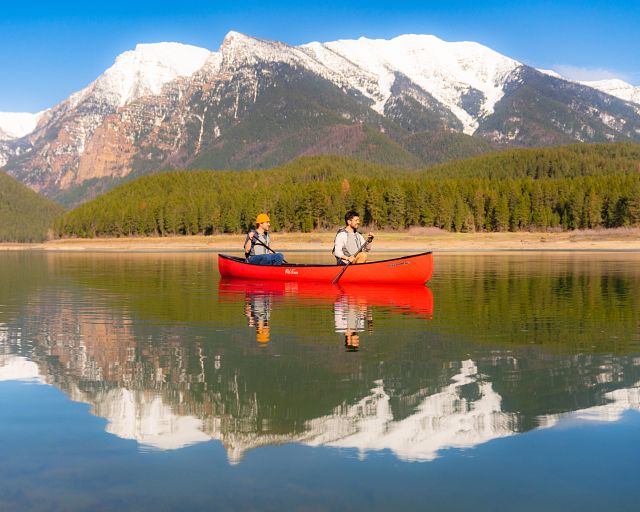
Canoe vs. Kayak: Different Types of Canoes
Not only is there a difference between canoes and kayaks, but there are differences between types of canoes, as well. The most frequent canoe types are river, recreational, whitewater, racing, and fishing. The materials used to construct canoes vary considerably: aluminum, fiberglass, Kevlar, and inflatable PVC are all common.
Wooden canoes have been used historically, back to when Native people created them to help them move swiftly through water. Old Town started their canoe production using bark. Today, wooden canoes can be used with common woodworking tools, are resistant to sun and water damage, and many find them to be more aesthetically pleasing than their counterparts.
Canoes are available with single and tandem seats, as well as four-person or larger capacity canoes, making the sport accessible for the entire family.
Solo Canoe
A solo canoe is a canoe meant to be paddled by one person. These are often lighter and more maneuverable than tandem canoes, making them a good choice for solo adventurers or those who want to move quickly.
Recreational Canoe
A recreational canoe is a canoe meant for leisurely trips on calm waters. They are often wider and more stable than other types of canoes, making them a good choice for beginners or those who want a relaxed experience.
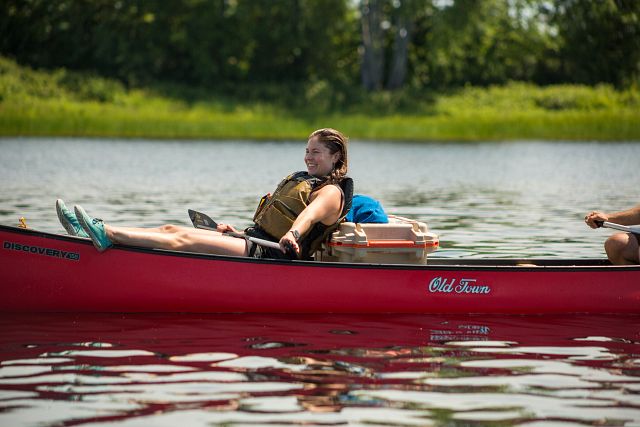
Tripping Canoe
A tripping canoe is a canoe meant for extended trips on moving waters. Tripping canoes are often longer and narrower than touring canoes, making them even faster but less stable.
Sporting Canoe
A sporting canoe is a canoe meant for racing or other active sports. Sporting canoes are often the longest and narrowest of all the types of canoes, making them the fastest but also the least stable.
Fishing Canoe
A fishing canoe is a canoe meant specifically for fishing. Fishing canoes are often wider and more stable than other types of canoes, making them a good choice for those who want to fish on the water.
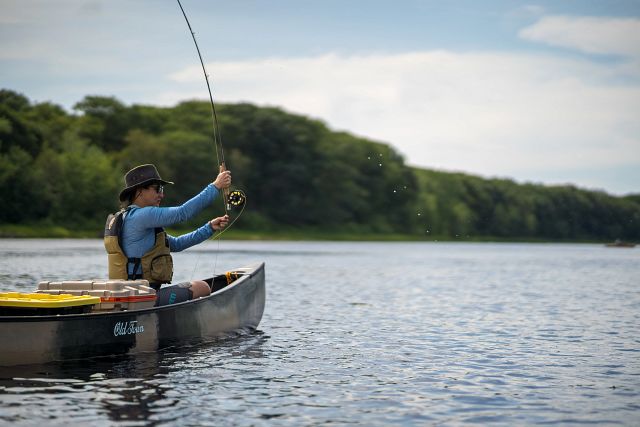
Canoe vs. Kayak: Different Types of Kayaks
Just like canoes, there are a variety of kayak options depending on what type of activity you're interested in. One of the most attractive aspects about kayaking is the large number of activities that it allows you to do-from the rush of whitewater rapids to the peace and quiet of a day on a lake.
Kayaks come in a variety of shapes, sizes, and designs. The design of kayak to use with each activity is unique, ranging from the short and broad play boat to the long sleek lines of the sea kayak. It might be difficult to tell these watercraft apart and select the one that is appropriate for your journey, so here are some helpful tips to get you on your way.
Sit Inside Kayaks
Sit-inside kayaks are the most common type of kayak. They're designed so that you sit inside the kayak, with your legs in front of you. Sit-inside kayaks are good for those who want protection from the elements and a more comfortable position for paddling.
Sit-on-Top Kayak
Sit-on-top kayaks are designed so that the paddler sits on top of the hull, rather than inside of it. They're stable and easy to get in and out of, making them a good choice for beginners or kayaking with kids. They are quickly becoming the popular choice for recreational kayakers.

Recreational Kayak
A recreational kayak is a good all-around choice for those who want to kayak for recreation and exercise. Recreational kayaks are usually shorter and wider than other types, making them slower but more stable.
Touring Kayak
Touring kayaks are designed for longer trips and have more storage space than other types. They're also faster and more efficient to paddle. If you're looking for something that will keep you comfortable and give you more space on a longer trip, consider buying a touring kayak.
Tandem Kayak
Tandem kayaks are designed for two people to paddle together. They're usually longer and wider than other types of kayaks, and they have two separate cockpits. These are great kayaks when you want to bring a kid, inexperienced kayaker, or a dog on board.
Fishing Kayak
Fishing kayaks are designed to provide a stable platform for fishing. They often have features like fish finders and rod holders. They are typically easy to maneuver and can reach spots that many motor boats can't.
There are different types of fishing kayaks, so research and see how each one can improve your angling game.

Canoe Kayak Hybrids
Canoe kayak hybrids are a cross between canoes and kayaks. They usually have an open cockpit like a canoe, but they're narrower and easier to paddle than a canoe.
Hybrid designs, like the Sportsman Discovery Solo 119 offers elements combining canoe and kayak designs, such as a canoe hull, kayak seat, and is paddled like a kayak.
Canoe vs. Kayak Paddling
Canoe paddling is a bit different than kayak paddling. Canoes are usually paddled with a single-bladed paddle, while kayaks are usually paddled with a double-bladed paddle.
When paddling a canoe, you alternate strokes on either side of the boat. When paddling a kayak, you use simultaneous strokes on both sides of the boat.
Canoeing and Paddling Technique
When you're canoeing, you'll want to use a J-stroke. This is a stroke that starts in the middle of the boat and extends out to one side. It then curves back around to the other side of the boat before returning to the middle. The J-stroke helps keep the canoe going straight.
Kayaking and Paddling Technique
To paddle a kayak, you'll use a stroke that starts on one side of the boat and extends out to the other. You then bring the paddle back to the starting position. This stroke is called the forward stroke. It's the most common paddling technique, and it's relatively easy to learn. Learn the ins and outs of this technique by reading our post "How to Paddle a Kayak."

Canoe vs. Kayak: Pros and Cons
Canoe Pros
- Canoes are often wider than kayaks, making them more stable.
- Because canoes are open, it's easy to get in and out of them.
- Canoes can accommodate more gear than kayaks.
Canoe Cons
- Canoes can be difficult to paddle solo.
- Canoes are less maneuverable than kayaks.
- Canoes can tip over more easily than kayaks.
Kayak Pros
- Kayaks are more maneuverable than canoes.
- Kayaks are easier to transport than canoes because they're lighter and smaller.
- Kayaks track better than canoes, meaning they go in a straight line more easily.
- Kayaks are easier to store than canoes.
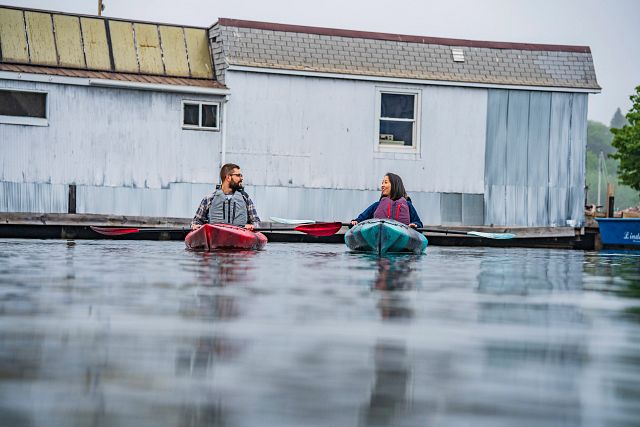
Kayak Cons
- Kayaks can be harder to get in and out of than canoes because they're enclosed. Though there is the exception with the very popular sit-on-top type of kayak where beginners to advanced kayakers alike can get in and out easily.
- Some people find kayaks less comfortable than canoes because you're sitting lower to the ground.
Canoe vs. Kayak: Which to Choose for You
So, is a canoe or a kayak best for you? The truth is that it depends. Canoes are more stable, easy to get in and out, and can accommodate more gear-eliminating much of the need to pack lightly. Because kayaks are more maneuverable than canoes, they make a great option for hunting and fishing. Anglers and hunters are able to maneuver into spots not reachable by foot or canoe and find more success in their hunt.
- Interested in a kayak? Visit our kayak selector.
- Interested in a canoe? Visit our canoe buying guide.






